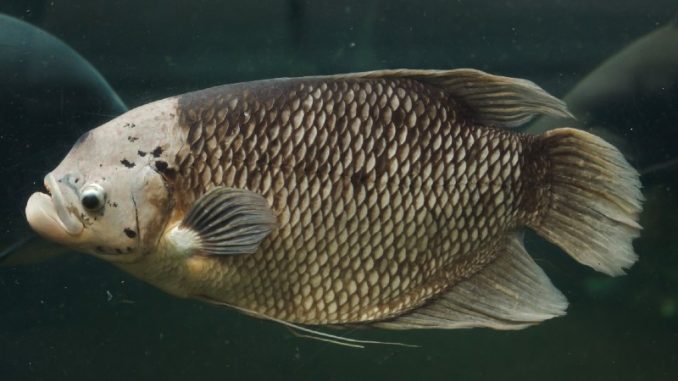
The giant gourami is a freshwater fish that is part of the Osphronemidae fish family.
Giant gouramis are popular fish among aquarists due to their easy-going nature and peaceful temperament. Giant gourami fish are large and full of personality, much like other gourami fish, and are easy fish for beginners to care for.
Finding tank mates for giant gouramis is easy. As long as giant gouramis live in a tank with other similar-sized fish, the gouramis will not cause any drama in the tank.
TABLE OF CONTENTS
Giant Gourami Facts & Overview
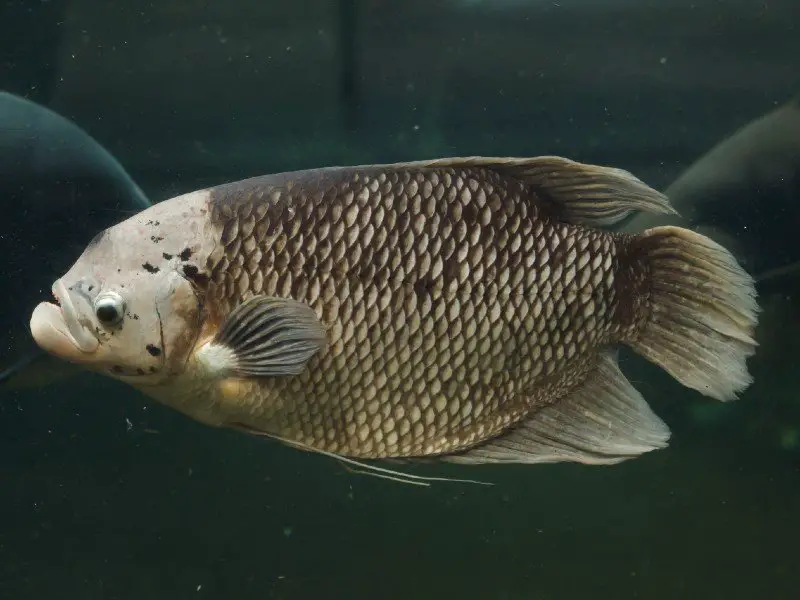
| Category | Rating |
| Care Level: | Easy |
| Temperament: | Peaceful |
| Color: | Soft golden yellow with pale blue stripes |
| Lifespan: | 2–5 years |
| Size: | Up to 20 inches long |
| Diet: | Omnivore |
| Family: | Osphronemidae |
| Minimum Tank Size: | 200 gallons |
| Tank Set-Up: | Freshwater with live plants |
| Compatibility: | Compatible with other large, peaceful fish |
Osphronemus goramy is the scientific name for the giant gourami. The name ‘Ospheronemus’ refers to the family of fish that the gourami belongs to. Giant gouramis are large compared to other fish in the Osphronemidae family, and therefore these gouramis are called giant gouramis.
In Southeast Asia, the giant gourami fish lives in slow-flowing rivers and streams, swamps, lakes, and marshes. Gouramis live in highly vegetated water in the wild, so they thrive in aquariums full of plants.
Aquarists who love keeping live plants and algae in the aquarium should consider keeping giant gouramis. Aquascaping the aquarium aesthetically and practically is important in a giant gourami tank.
Giant gouramis cost $40 to $200. Giant gourami fish are popular aquarium fish and easy to purchase commercially, but giant gourami fish numbers are falling in the wild.
Purchasing giant gouramis from reputable breeders will increase the chances of the gourami living a long and happy life with few health issues. Any local aquarium shop should have giant gouramis available for purchase.
Appearance & Behavior
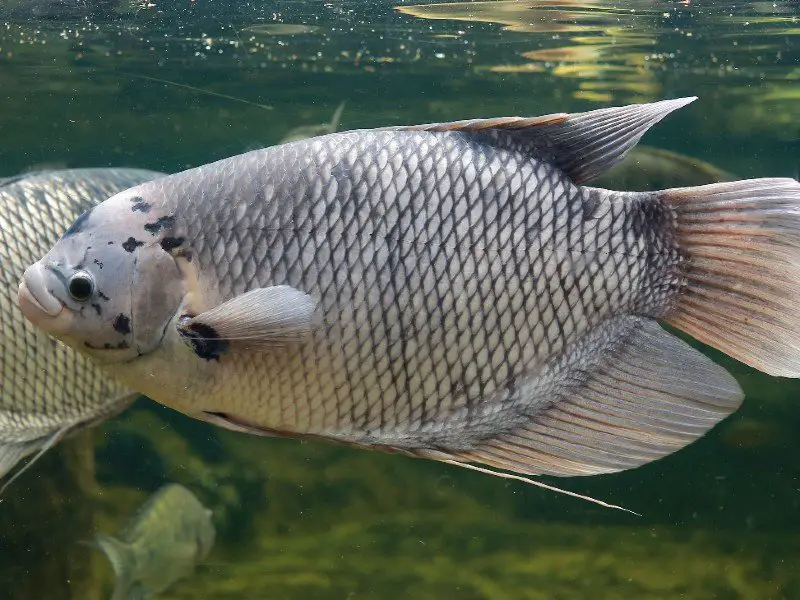
The giant gourami is pale with soft yellow/gold scales and light blue/silver stripes. Giant gouramis are large fish, measuring up to 20 inches when fully mature.
Giant gouramis have pointed snouts and unique flat heads, which is unusual for gouramis and makes giant gouramis easy to identify. Aquarists often introduce giant gouramis into large aquariums as these fish have a lot of presence.
Like every other gourami species of fish, male giant gouramis are much smaller and more streamlined than female fish. Female giant gouramis have a rounded dorsal fin, whereas the male fish have a more pointed dorsal fin. Male giant gouramis look streamlined in comparison to female giant gouramis who have rounded bellies.
Pet shops and aquariums sell giant gouramis as juveniles. Fishkeepers should expect these small and dainty-looking gouramis to grow up to 20-inches long, and therefore the tank must be large enough to accommodate such large fish.
Giant gouramis vary significantly in appearance. Here are some similarities throughout the species to look out for when identifying giant gouramis:
Flathead: Most gourami fish have flat heads. The top of the gourami fish’s head is only slightly curved, making it look flat compared to other fish in the tank.
Flat body: Gouramis have flat bodies, which is prominent when looking at these fish head-on.
Pointed snout: A pointed or pouty-looking snout is common amongst species of gourami fish.
Larger female fish: Female gouramis are always larger and stockier than male fish. Even the dwarf gourami females are chunkier than male dwarf gouramis.
Typical Behavior
Giant gouramis are dominant fish. They have a lot of presence in a fish tank due to their size and territorial behavior. Male gouramis will fight one another more than females, so avoid keeping more than one male in a tank.
Juvenile giant gouramis will fight one another in the tank, but once the gouramis reach maturity, they calm down and keep to themselves. Male fish will fight if there are too many male fish in the tank. The gourami “kiss” is an aggressive ritual that males perform with one another to establish dominance.
Adult giant gouramis avoid interaction with other fish in the tank. These gouramis will swim nearer the top of the tank to come up for air now and then. Keeping a lid on the tank is vital to stop the giant gouramis from jumping out of the aquarium.
Giant gouramis build bubble nests when ready to breed. This gourami species will start to show signs of sexual maturity from six months old. The appearance of bubble nests in the tank is the first sign that the fish are sexually mature and ready to mate.
Giant Gourami Care
Giant gouramis are easy to fish to care for. Beginner fish keepers often choose giant gouramis due to how little care and attention the fish need to thrive.
As long as giant gouramis have plenty of room in the aquarium to swim around, and there are more live plants than artificial accessories in the aquarium, the gouramis will live a long and happy life. Setting up the aquarium to resemble the fish’s natural habitat is vital for the gouramis wellbeing.
Feeding giant gouramis is easy. This species of gourami fish prefer a herbivore diet over frozen or live food, but some live food is necessary for giant gouramis to have a balanced diet.
Disease
Giant gouramis are prone to the common diseases and infections found amongst aquarium fish. The best way to prevent diseases and infections from spreading is to quarantine new fish for three weeks before introducing the fish into a community tank. Performing regular water changes is also a disease prevention method.
Some diseases and infections can be treated with more frequent water changes, while others will require antibiotics.
The following diseases and infections threaten giant gouramis in aquariums:
- Bacterial infections
- Constipation
- Hole in the head disease
Giant gouramis are hardy and usually only become sick if the tank conditions are poor. Keeping the aquarium clean is the best way to prevent problems.
Habitat and Tank Requirements
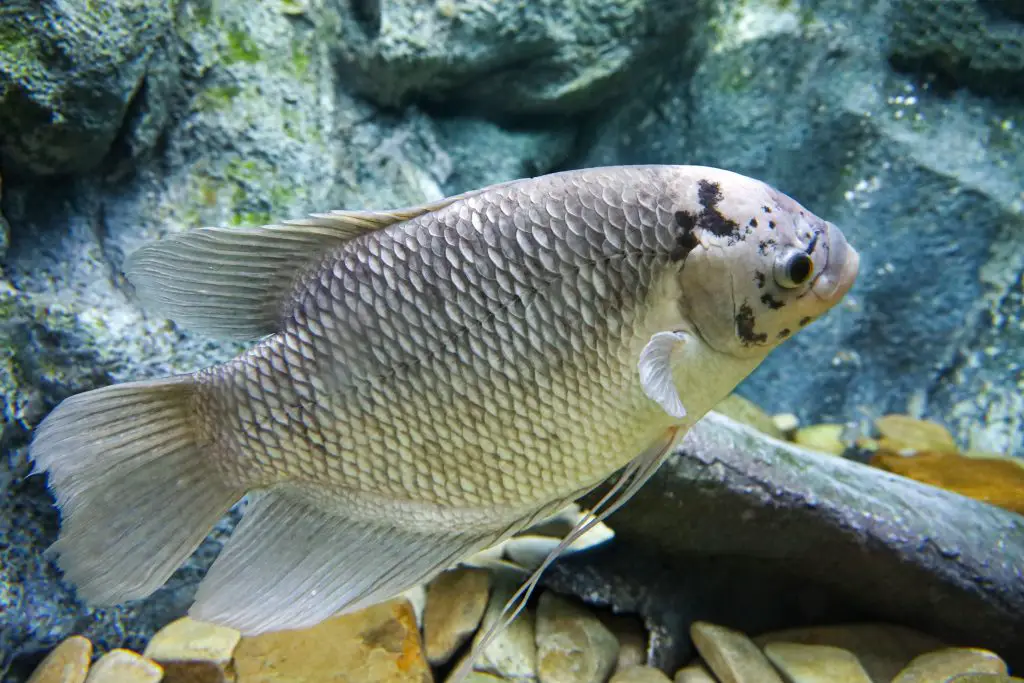
Giant gouramis swim in highly vegetated and slow-flowing water in the wild. This gourami species will even enter flooded forests and marshlands in the wet seasons, so setting up the aquarium with plenty of live plants and algae will make the gouramis feel at home.
Dim lighting will make giant gouramis feel relaxed in the aquarium. Avoid adding bright white lighting as this will cause the gouramis to display signs of distress.
Tank Conditions
Keeping the tank conditions constant and appropriate for giant gouramis is important. Ensure the tank is set up and decorated correctly by following the guidelines below:
Water Type: Giant gouramis are freshwater fish. The best water to use for a freshwater tank is tap water left to settle for a few days. Dechlorinators may be used to balance tap water to make the water instantly safe for fish.
Tank Size: Adult giant gourami fish need a lot of tank space. Fish keepers should keep adult fish in a tank that can hold at least 200 gallons of water or more. Failing to provide giant gouramis with the sufficient space required will result in depressed, unhealthy fish that will not live long.
Desired Water Temperatures: These gouramis can tolerate a wide range of water temperatures. The temperature in the tank should be between 68.0° to 86.0° Fahrenheit. Keep the temperature as consistent as possible to avoid stressing out the giant gouramis.
Keeping the room temperature consistent with the tank temperature is crucial. Giant gouramis surface for air, and drastic changes in water and air temperatures will damage the gouramis labyrinth organ.
Substrate: Sand or gravel is the perfect substrate for a giant gourami tank. Look for a dark-colored substrate that will make the gouramis pale complexion pop.
Plants: Giant gouramis love live plants. Keeping plenty of live plants in a gourami tank will make the fish feel at home and comfortable in the aquarium.
Here are some of the best plants for a giant gourami tank:
- Anubias — native to Western Africa, the anubias plant is an aquatic and semi-aquatic plant species that produce flowers and grows in rivers and streams.
- Java fern — a popular freshwater aquarium plant, Java fern is hardy, easy to grow, and perfect for decorating a large tank. Java fern provides a cozy hiding space for shy fish.
- Amazon sword — aquarists can plant Amazon sword in gravel or sand. The leaves of an Amazon sword plant are vibrant and green and can grow up to 20 inches long.
- Water wisteria — an excellent plant for large fish tanks. It grows in marshy waters in the wild and is native to Bangladesh, Bhutan, India, and Nepal.
Giant gouramis like to nibble at live plants, which will harm delicate plants. Decorating the aquarium with robust plants is the best practice before incorporating delicate foliage into the tank.
Decorations: Scattering bits of driftwood and logs in the tank is enough decoration in a giant gourami tank. Giant gouramis need plenty of room to swim, and artificial decorations and plastic props take up a lot of tank space.
Water pH Level: The water pH level in a giant gourami tank should be between 6.8 and 7.8.
Water Filters and Bubblers: Bubblers are not necessary for giant gourami tanks. Giant gouramis swim in slow-flowing, calm water in the wild, and the presence of water bubblers could cause the fish distress. Giant gouramis need high-quality filtration in the tank as gouramis produce a lot of waste.
Tank Mates
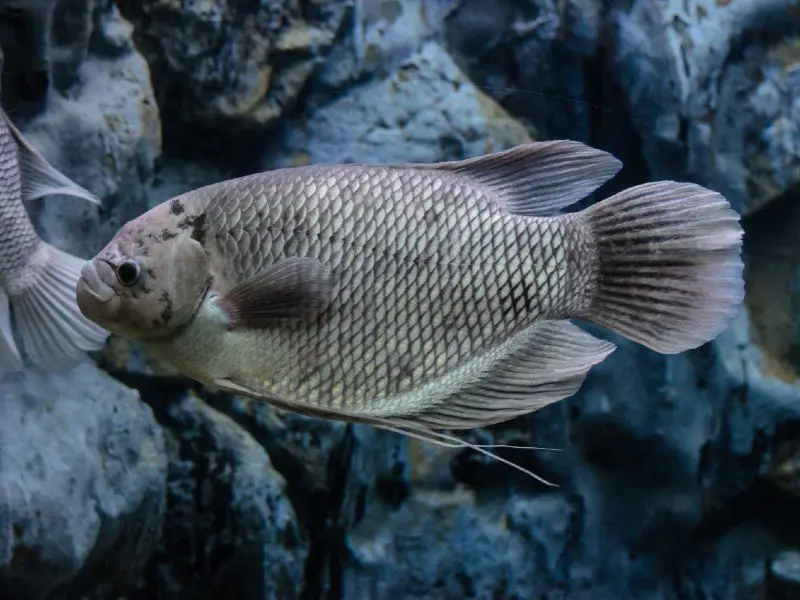
Giant gouramis stay away from other fish in the aquarium and can become territorial or aggressive towards other large fish or male gourami fish.
Choosing compatible tank mates is important to keep the peace in the aquarium. The following tank mates are great in a giant gourami tank:
- Knifefish
- large Catfish
- Loricariid Catfish
Giant gouramis are usually the most dominant fish in the tank. These gouramis may nip and bite small, speedy fish if the giant gouramis feel irritated.
Diet and Feeding
Giant gouramis live in highly vegetated environments in the wild. In a giant gourami’s natural habitat, the fish will have an endless supply of plants and algae to feed on, with the chance of catching the occasional worms. It’s also common for giant gouramis to feed on dead animals in the wild.
You should feed giant gouramis a mixture of algae-based flake food and freeze-dried bloodworms, and brine shrimp. Feed giant gouramis twice daily, and only give the fish enough food to consume in two to three minutes to avoid overfeeding the fish.
Breeding
Breeding giant gouramis are extremely easy. Giant gouramis participate in a mating ritual called spawning. Females lay over 1000 eggs that float to the surface, ready for the male fish to fertilize.
The male gouramis will collect the eggs in their mouth and take the eggs to the bubble nests. Eggs take about 40 hours to hatch. The male gouramis will protect the fry for two weeks. Female fish show no maternal instincts and often try to eat the fry.
Giant gouramis will breed easily in a large fish tank. The ideal breeding tank size for gouramis is 250-gallons or bigger.
Should You Get a Giant Gourami for Your Aquarium?
Giant gourami fish are great for beginner and experienced aquarists. These gouramis are easy to care for and demand little attention, so keeping them rewarding and takes up little time.
Aquarists with large tanks and a passion for freshwater fish will enjoy keeping giant gouramis, as giant gouramis are happy, peaceful fish with quirky personalities that are easy to bond with.

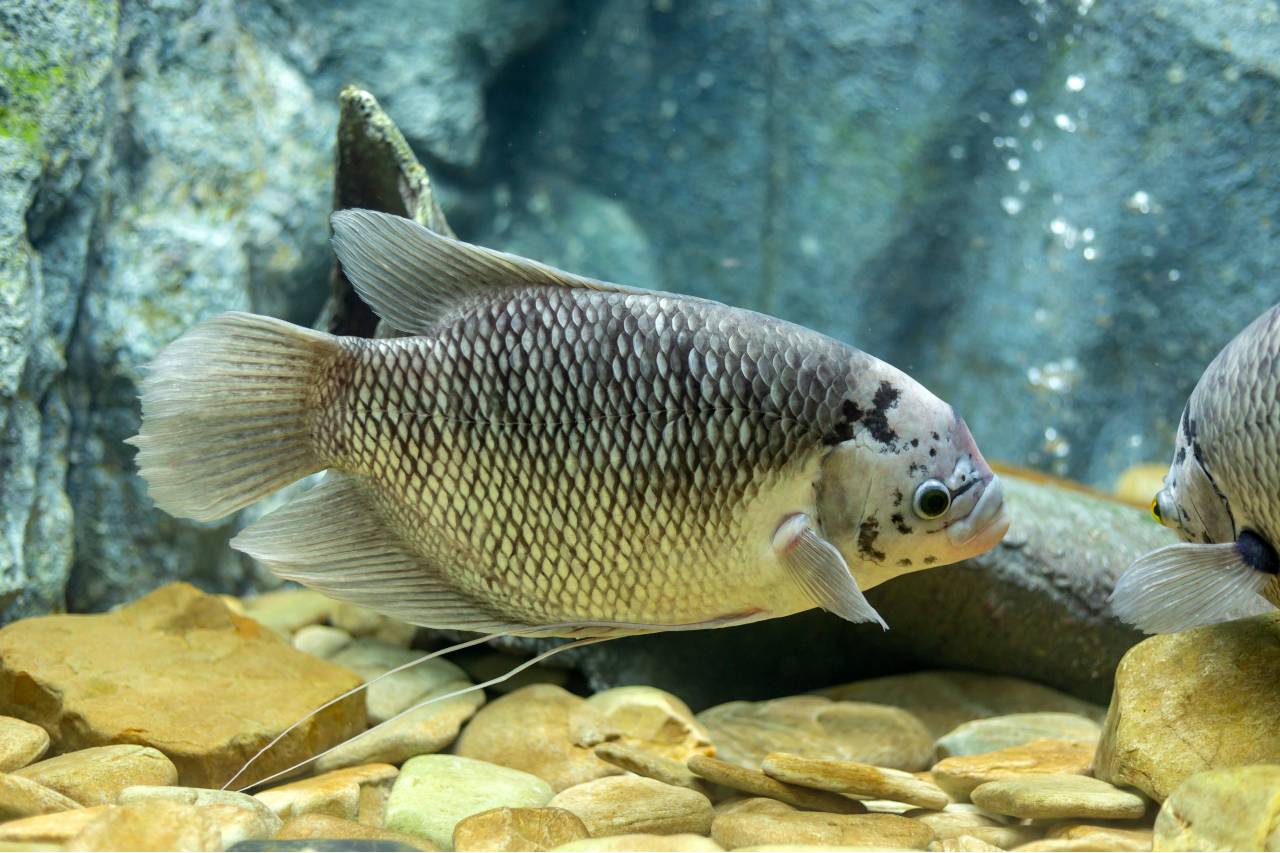
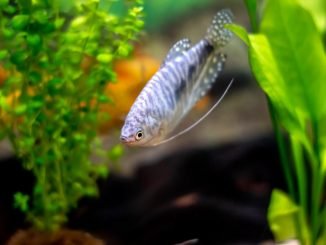
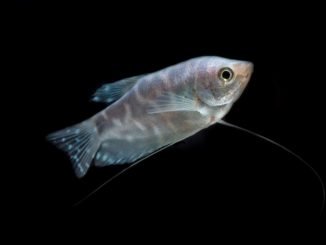
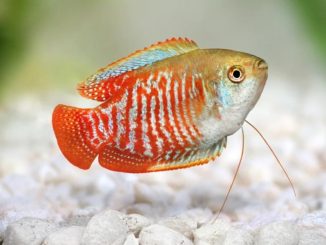
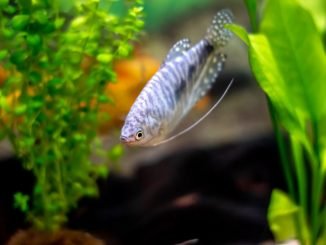
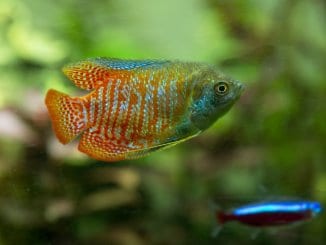
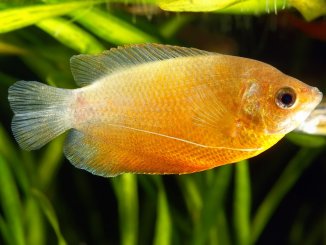
Giant gouramis have a lifespan of about 15–20 years.